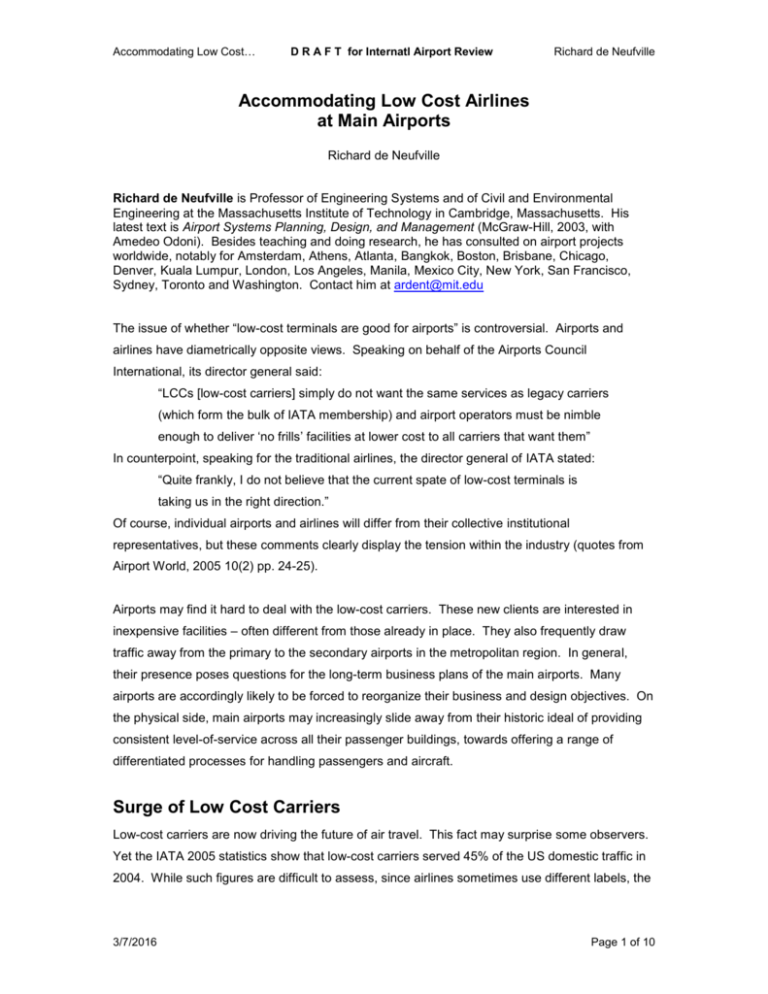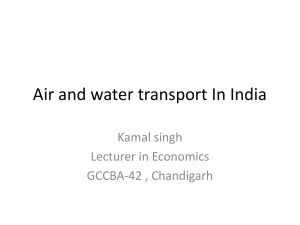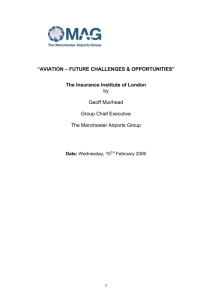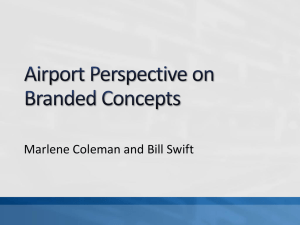ALLC international airport review draft
advertisement

Accommodating Low Cost… D R A F T for Internatl Airport Review Richard de Neufville Accommodating Low Cost Airlines at Main Airports Richard de Neufville Richard de Neufville is Professor of Engineering Systems and of Civil and Environmental Engineering at the Massachusetts Institute of Technology in Cambridge, Massachusetts. His latest text is Airport Systems Planning, Design, and Management (McGraw-Hill, 2003, with Amedeo Odoni). Besides teaching and doing research, he has consulted on airport projects worldwide, notably for Amsterdam, Athens, Atlanta, Bangkok, Boston, Brisbane, Chicago, Denver, Kuala Lumpur, London, Los Angeles, Manila, Mexico City, New York, San Francisco, Sydney, Toronto and Washington. Contact him at ardent@mit.edu The issue of whether “low-cost terminals are good for airports” is controversial. Airports and airlines have diametrically opposite views. Speaking on behalf of the Airports Council International, its director general said: “LCCs [low-cost carriers] simply do not want the same services as legacy carriers (which form the bulk of IATA membership) and airport operators must be nimble enough to deliver ‘no frills’ facilities at lower cost to all carriers that want them” In counterpoint, speaking for the traditional airlines, the director general of IATA stated: “Quite frankly, I do not believe that the current spate of low-cost terminals is taking us in the right direction.” Of course, individual airports and airlines will differ from their collective institutional representatives, but these comments clearly display the tension within the industry (quotes from Airport World, 2005 10(2) pp. 24-25). Airports may find it hard to deal with the low-cost carriers. These new clients are interested in inexpensive facilities – often different from those already in place. They also frequently draw traffic away from the primary to the secondary airports in the metropolitan region. In general, their presence poses questions for the long-term business plans of the main airports. Many airports are accordingly likely to be forced to reorganize their business and design objectives. On the physical side, main airports may increasingly slide away from their historic ideal of providing consistent level-of-service across all their passenger buildings, towards offering a range of differentiated processes for handling passengers and aircraft. Surge of Low Cost Carriers Low-cost carriers are now driving the future of air travel. This fact may surprise some observers. Yet the IATA 2005 statistics show that low-cost carriers served 45% of the US domestic traffic in 2004. While such figures are difficult to assess, since airlines sometimes use different labels, the 3/7/2016 Page 1 of 10 Accommodating Low Cost… D R A F T for Internatl Airport Review Richard de Neufville trend is clear. In Canada, the low cost Westjet has been humming along while the major legacy carriers (Canadian and Air Canada) went bankrupt. In Europe, Ryanair and easyjet have grown rapidly and rank among the strongest passenger airlines in the world. In total, the various low cost European airlines already account for around 1/3 of all passenger traffic in the European Union. In Brazil, Gol is taking over rapidly as the national flag carrier, Varig, meanders through financial difficulties. In Asia finally, AirAsia, Lion Air, and NOK – unheard of at the turn of the century – by 2004 already carried 6% of the traffic in that region The decline of the legacy carriers is accentuated by the rise of the integrated freight airlines such as UPS, Fedex, and DHL. Contrary to appearances that these are trucking companies, Fedex for example has more major jet aircraft than Lufthansa, British Airways or Air France; and UPS is in the same league. These carriers have seized the lion’s share of the market for profitable air cargo away from the legacy carriers. Most importantly, from the perspective of metropolitan main airports, these innovative carriers often use secondary airports in metropolitan areas. Thus beyond their main hubs in Memphis and Louisville, Fedex and UPS serve such airports as Chicago/Rockport, Los Angeles/Ontario; Manila/Subic Bay; San Francisco/Oakland, and Toronto/Hamilton. They are developing their own networks of services independent of those of the legacy carriers and the traditional main airports. Dominant market capitalizations underscore the rise of innovative, non-legacy carriers. The “market cap” is the investors’ valuation of a company. It is the quotient of the number of shares in the company times the market price per share. It measures the financial power of a company, taking into account both its current situation and future prospects. Table 1 compares the situation of the innovative and low-cost airlines to the legacy carriers. In brief, the low-cost carriers have the financial clout, and the legacy carriers are far behind. As of February 2006, Southwest was by far the most valuable passenger airline in the world, with a market cap about equal to those of British Airways, and Air France together. Overall, the low cost carriers dominate the pack, and most of the US legacy carriers have been bankrupt. Intelligent approach to the air transport business should recognize that, in thinking about airport projects, airports should pay attention to the companies that have the resources. Conversely, it is not a good idea to take on long-term obligations based on clients that have neither money now nor good prospects. While this is elementary good business practice, it is important to emphasize the desirability of paying attention to the now and future leaders. Airport planning all too easily assumes that past players represent the future. 3/7/2016 Page 2 of 10 Accommodating Low Cost… D R A F T for Internatl Airport Review Richard de Neufville Table 1: Market Capitalizations of Leading Airlines (Billions of US $) in February 2006 Airline Market Cap Airline US$, Billions Type UPS 80 Integrated Cargo Fedex 30 Integrated Cargo Southwest 13 Low-Cost Singapore 9 est Ryanair 8 Low Cost British 6.3 Air France 6.2 Gol 5.7 Low Cost Lufthansa 5.5 est United (new) 3.8 American 3.7 US Airways Group 2.4 easyjet 2.1 Low Cost jetBlue 1.7 Low Cost Continental 1.7 Virgin Blue 1.6 est Low Cost Air Tran 1.5 Low Cost Japan Airlines 1.1 est Alaska 0.8 Westjet 0.5 est Low Cost Delta 0.2 Northwest ~0 Air Canada ~0 United ~0 Source: finance.yahoo.com and industry estimates Bankruptcy History Yes, until 2006 Yes, until 2006 Yes, pre 2000 Yes Yes Yes Yes Relevant Characteristics of Low-Cost Carriers Low-cost carriers operate differently from the legacy carriers. They are not just cheap versions of the bankrupt traditional carriers -- such as Delta, Northwest, Sabena, Swiss, US Airways, and United -- that can offer lower prices because they employ younger, non-union staff and are not paying pensions for retired workers. Beyond those advantages, low-cost carriers have a new business model of how they deliver services to metropolitan regions, what kind of airport facilities they desire, and how much they are willing to pay for them. Key common features of their strategic plans are their aim to avoid: Congestion, and Expensive capital charges. Low cost carriers prefer to avoid congested airports because this strategy lets them achieve extraordinarily high aircraft productivity. They fly their aircraft as much as possible by minimizing unproductive time. They achieve this by avoiding congestion that keeps aircraft on the ground, either because they wait for air traffic control clearance, have to queue up for a open gate, or 3/7/2016 Page 3 of 10 Accommodating Low Cost… D R A F T for Internatl Airport Review Richard de Neufville have long taxi distances. This is a central aspect of their service, just like the easily observable fact that they cut the turn-around time on the ground to a minimum (for example, about 25 minutes in the case of Southwest, in contrast to the more typical hour or more used by the traditional carriers). Low cost carriers thus commonly avoid congested airports and fly instead to secondary airports in metropolitan regions, notably Boston/Providence and Boston/Manchester, Dallas/Love, Los Angeles/Long Beach and Los Angeles/Ontario, Miami/Fort Lauderdale, and San Francisco/Oakland and San Francisco/San Jose in the United States; and Brussels/Charleroi, Frankfurt/Hahn, London/Luton and London/Stansted, Oslo/Torp, Rome/Ciampino, and Stockholm/Skvasta in Europe; and Hong Kong/Macao, Manila/Clark, Melbourne/Avalon, and Singapore/Johore Bahru in Asia and Australia. The preference of low-cost carriers for uncongested airports does not mean they will not serve busy, congested main airports. They certainly do when they judge that the market opportunities outweigh the disadvantages of a congested facility. Thus jetBlue operates out of New York/Kennedy and Boston/Logan; Southwest is in Los Angeles/International and Philadelphia, and Westjet in Toronto/Pearson. Moreover, to the extent that legacy carriers continue to shrink, we may expect that low-cost carriers will increasingly operate out of main airports. Low-cost carriers also reduce costs by avoiding expensive ground facilities. This practice is frankly new in the airline industry. Traditionally, airlines could and did generally neglect the cost of ground facilities – these were barely noticeable in their cost structure. A $20 per passenger airport fee is not salient in a $500 fare. However, it is a large expense for an airline charging $100 or less for a flight. Low-cost airlines achieve low rental costs per passenger by using older, less expensive facilities, and by using their space more intensely, and thus requiring less of it. Low-cost airlines reduce their need for expensive facilities by putting more flights, and thus more passengers, through each gate. They do this by turning-around aircraft quickly. The results can be remarkable. JetBlue apparently processes around 600,000 passengers annually through its gates at New York/Kennedy – in contrast to the approximately 250,000 that American Airlines achieves. The low-cost carriers thus need far fewer gates or can process many more passengers through a building than the legacy carriers. They thus reduce their costs per passenger substantially. At Los Angeles/International, Southwest manages 10 daily turns per gate whereas other airlines only get about 4 on average. Low-cost airlines achieve particularly lower costs by combining high throughput per gate with the use of older, cheaper facilities. In Boston, for example, jetBlue pays about $1.5 million per gate annually for older renovated space, whereas its bankrupt competitor Delta is responsible for 3/7/2016 Page 4 of 10 Accommodating Low Cost… D R A F T for Internatl Airport Review Richard de Neufville about $2.1 million in a brand-new building. JetBlue’s apparent 40% advantage in this respect is magnified when one considers that its throughput per gate is about twice that of Delta. Moreover, low-cost airlines also avoid expensive facilities for their passengers who pay parking and other airport fees. Southwest indeed sells its flights from Boston, Dallas, Miami, and San Francisco through both its cheap fares and the cheap costs of secondary airports in these metropolitan regions (Providence and Manchester; Dallas/Love, Fort Lauderdale and Oakland respectively). Dispersal of Airport Traffic The twin objectives of using uncongested airports and inexpensive facilities have led many lowcost airlines to provide their services at secondary airports across metropolitan regions, as Table 2 shows. Note that a secondary airport is any airport that effectively serves and competes for passenger traffic from a metropolitan area. It does not have to be in the city or in the relevant metropolitan area. It can be in different states or even countries. Thus Southwest serves passengers in the Boston area via service at Providence, Rhode Island, and Manchester, New Hampshire. These cities are 70 and 50 miles away from Boston, but are the closer airports for a significant fraction of Boston travelers. Similarly, Malmo, Sweden is effectively a secondary airport for Copenhagen, Denmark, as a bridge connects the two cities. Table 2: Low-cost Carriers Often Serve Secondary Airports in a Metropolitan Region. Metropolitan Region Secondary Airport Low-cost Airline Boston Boston Brussels Copenhagen Dallas/Fort Worth Frankfurt Glasgow Hamburg Houston/Galveston London London Los Angeles Manchester (UK) Melbourne (Australia) Miami Milan New York Oslo Paris Rome San Francisco Providence Manchester, NH Charleroi Malmo, Sweden Love Hahn Prestwick Lübeck Hobby Stansted Luton Long Beach Liverpool Avalon Fort Lauderdale Orio al Serio Islip Torp Beauvais Ciampino Oakland Southwest Southwest Ryanair Ryanair Southwest Ryanair Ryanair Ryanair Southwest Ryanair easyjet jetBlue easyjet Jetstar Southwest Ryanair Southwest Ryanair Ryanair easyjet, Ryanair Southwest 3/7/2016 Page 5 of 10 Accommodating Low Cost… D R A F T for Internatl Airport Review Richard de Neufville Stockholm Skvasta Ryanair Vancouver Abbotsford Westjet Source: de Neufville Multi-Airport Systems database drawn from various reports. The rise of the low-cost carriers has been accompanied by a remarkable redistribution of airport traffic across major metropolitan areas. Traffic at primary airports, such as Boston/Logan, Miami/International, San Francisco/International and London/Heathrow has grown slowly or even dropped while traffic at the secondary airports of Boston/Providence and Boston/Manchester; Miami/Fort Lauderdale; San Francisco/Oakland and San Francisco/San Jose; and London/Stansted and London/Luton has soared. Major metropolitan airports have been losing much of their former pre-eminence, as Table 3 documents. Table 3: Example Drops in Market Share of Passengers for Primary Airports Correlated with Rise of Low-Cost Carriers Metropolitan Primary Market Share (%) in Region Airport 1994 2004 Boston Logan 90 72 Miami International 69 56 San Francisco International 68 58 London (UK) Heathrow 65 53 Source: de Neufville Multi-Airport Systems database drawn from various reports In general, major airports are vulnerable to this kind of redistribution of traffic since they typically have secondary airports. In the United States, this is true of Boston, Chicago, Dallas/Fort Worth, Houston, Los Angeles, Miami, New York, Orlando and Washington. Worldwide, this list includes Brussels, Frankfurt, London, Milan, Moscow, Osaka, Paris, Rome, Tokyo and others. Furthermore, the situation extends beyond passenger traffic. Freight carriers such as Fedex and UPS have also diverted much traffic to secondary airports. Meanwhile, at the Main Airports Many factors associated with low-cost carriers have put a number of the main airports in a bind. In general, they face some combination of the following issues: declining market shares; the enfeeblement of their traditional primary clients a legacy of excellent, yet possibly inappropriate facilities; an entrenched mindset. Declining market shares, along with other factors that decreased traffic since 2001, has economically stressed many main airports. Several are far behind the projections on which they 3/7/2016 Page 6 of 10 Accommodating Low Cost… D R A F T for Internatl Airport Review Richard de Neufville based major developments. San Francisco/International, for example, has been struggling to cover its investments in its huge International terminal, automated people-mover, and the extension of the BART rail line. The financial enfeeblement of the legacy carriers has been bad news for the airports have having them as principal clients. At best, the bankrupt airlines will pay the anticipated rentals with some possible legal proceedings and other delays. More generally, weakened legacy carriers will cut flights, staff, their needs for space and facilities, and will try to cut their annual rentals. These moves will also decrease concessionaire and other commercial revenues. The main airports will need new clients to fill in the facilities vacated by the shrinking legacy carriers. They thus need to attract the low-cost carriers, which provide the alternative. However, many of the assets of main airports may be poorly suited to the needs of the low-cost carriers. Following the lead of the legacy carriers, their formerly powerful clients, main airports have built excellent, attractive facilities that can provide high levels of service. While these made sense financially for airlines charging high fares, they are not best for low-cost carriers minimizing costs. In practice, the low-cost carriers may choose to use only a fraction, or the oldest less expensive facilities. For example, jetBlue in New York/Kennedy has preferred to use one of the oldest and most cramped passenger buildings on the site. Similarly, Ryanair declined to use the 2 level mid-field buildings served by people-movers at London/Stansted, and opted instead to require its passengers to walk to their aircraft through a rudimentary single story structure. Some airport managers seem to reflect a mindset stuck in the past. A recurrent mantra is that “We have a good base of local traffic, and it doesn’t matter if current airlines go away, other airlines will appear to serve our passengers and use our facilities.” This reasoning was valid when air transport was regulated. However, it is now doubly flawed: First, “local traffic” from a metropolitan area can increasingly be served by alternative airports. “Local” passengers do not have to use the main airport when they have alternative secondary airports such as San Francisco/Oakland and San Francisco/San Jose, or Dallas/Love instead of Dallas/Fort Worth. Second, the low-cost airlines replacing the legacy carriers are unlikely to accept the financial obligations held by traditional airlines. They may request and get – because they have alternative airports to serve and will be courted by the main airports – advantageous financial arrangements. A number of airport managers need to recognize that their mindsets about creating, leasing and running their airport buildings need to be brought up-to-date with the reality of low-cost airlines. 3/7/2016 Page 7 of 10 Accommodating Low Cost… D R A F T for Internatl Airport Review Richard de Neufville The architectural community responsible for creating grandiose passenger buildings also has to come to grips with the new market. Leading architects are proud of the remarkable structures they created – Sir Norman Foster at Hong Kong/Chep Lap Kok; Helmut Jahn at Chicago/O’Hare and Bangkok/Suvarnabhumi; Richard Rogers at Madrid/Barajas and London/Heathrow; and Safdie and Skidmore, Owings and Merrill at Tel Aviv and Toronto/Pearson. The question, however, is whether such masterpieces are appropriate to the clientele that they may now have to serve. Will Bangkok’s magnificent new airport attract the passengers it was designed for, when the low-cost Asian airlines could use the older, cheaper Bangkok/Don Muang? Will the US $8 billion new Terminal 5 at London/Heathrow be competitive against the low-cost facilities used by Ryanair and easyjet at London/Stansted, London/Luton and elsewhere? The effect of low-cost carriers is a real threat to main ports. For example, Zürich airport found itself saddled with: a bankrupt and now defunct airline, Swissair; debts from a $2.8 billion building program; an elegant mid-field passenger building whose capacity was not needed. The airport increased passenger charges drastically to cover its financial obligations but thereby drove low-cost easyjet to the competitive airport of Basel/Mulhouse. If airport managers do not cater to the low-cost airlines, they may drive this important clientele away. What are main airports doing? Airport managers are not agreed about how to deal with the rise of the low-cost carriers. At one extreme, some airports argue that they offer first-class service and will not ruin their brand by providing cheap facilities for low-cost carriers. Thus Hamburg refused to cater to Ryanair, which then based itself at nearby Lübeck, and is rapidly building up traffic at the expense of Hamburg. Several airports have brought on brand-new, generously designed new terminals. For example: Dallas/Fort Worth inaugurated a new terminal for American Airlines, at a cost of $1.2 billion for around 25 gates, or about $50 million per gate; Seattle/Tacoma opened its South Terminal Expansion project costing $587 for 14 gates, or somewhat more that $40 million per gate; and Toronto/Pearson has a new terminal complex with an estimated cost, including access highways and parking, of around US$3 billion. These facilities were designed in the mid 1990s, before the legacy carriers, the traditional clients for the main airports, went bankrupt, and before the surge of low-cost airlines. A number of main airports have inherited such legacies and must live with them as best they can. 3/7/2016 Page 8 of 10 Accommodating Low Cost… D R A F T for Internatl Airport Review Richard de Neufville Other airports however recognized the need to provide cost-effective airport passenger buildings consistent with the needs of the low-cost carriers. Thus: Detroit Metro is replacing 26 gates for about $443 million or around $17 million per gate; American Airlines opened its 34 gate terminal at New York/Kennedy for about $1.1 billion or $30 million per gate -- after a 25% cost reduction to remain competitive; and The 22 gate Delta building in Boston cost about $400 or $19 million per gate. When comparing carriers that use facilities so differently, the cost per passenger served is a better metric than the cost per gate. Consider the case of jetBlue that is developing 26 gates New York/Kennedy for around $650 million or $25 million per gate. This looks high, but is misleading. Low cost airlines that use gates very efficiently correspondingly have to increase the relative importance of security and other facilities per gate. When we compare the investment per annual passenger through a gate, the jetBlue building at New York/Kennedy costs about $40 per annual passenger served, in contrast to about $130 for the American Airlines passenger building across the way. Some airports have recognized the necessity of catering to low-cost airlines. Among others: Berlin/Schőnefeld has dedicated a charter flight building to the use of easyjet; Geneva has created a low-cost passenger building; Kuala Lumpur is developing a low-cost building near its cargo facilities; Paris/de Gaulle has been using Terminal 9 as a low-cost and charter facility; Singapore/Changi will open a low-cost passenger building in 2006; Warsaw has reactivated an old building especially for low-cost airlines. The track record however reflects the airport managers’ ambivalence about dealing with low-cost carriers. Typically, they place low-cost facilities at some remote, hard to reach spot. Both at Paris/de Gaulle and at Kuala Lumpur, the low-cost carriers are far from the rail service serving the airport – which is ironic since price-conscious travelers on low-cost carriers are the ones most likely to use public transport. So far, airport managers have been reluctant to incorporate lowcost facilities into the range of the main offerings. What should main airports be doing? Managers of main airports need to recognize that low-cost carriers have become significant clients. Yet while they obviously should deal with this reality, they may not find this easy to make the profound attitudinal changes required. And some professionals may be in denial. 3/7/2016 Page 9 of 10 Accommodating Low Cost… D R A F T for Internatl Airport Review Richard de Neufville Acknowledging that the low-cost business model will be a driving force in air transportation requires a deep shift in attitudes and expectations. It imposes a discipline of economy and simplicity that runs counter to tradition. Major airport passenger buildings have been conceived on a grandiose scale either as important marketing statements for an airline (usual in the United States) or as gateways. Either way, they have usually featured impressive multi-story entrance ways, expensive signature roofs (as at Bangkok/Suvarnabhumi, Denver/International, London/Heathrow Terminal 5, Osaka/Kansai, Madrid/Barajas, etc), marble floors and walls, and so on. Airport terminals have been among the largest, most impressive, and most beautiful metropolitan structures. They have also been among the most expensive. Abandoning this tradition will not be easy. The corollary is that airports may have to offer differentiated products, most obviously between full-service and low-cost airlines. This possibility will require an attitudinal shift. Although many airports offer small instances of differentiated products (such as bussed connections to charter aircraft) these have generally been hidden from view. Many airport managers will not find it easy to bring differentiated products out of the closet and make them a centerpiece of the airport business plan. Product differentiation may extend from the design of terminals to airport services such as security, passport control and baggage handling. Here again, there has been bureaucratic and other resistance to such developments: fast track lanes for first-class passengers or “trusted” travelers are rare. Airport managers have been reluctant to let their clients pay for more rapid service (which implies more agents, not less secure operations). Such developments may well appear however. Product differentiation is the hallmark of a modern consumer economy. We are long past notions of consumer regimentation, either as a production rationale (illustrated by the old Ford idea that people “can have any color they want, as long as it’s black”), or as a Maoist political philosophy. Transition to product differentiation in the design and operation of airport passenger buildings is likely to arrive sometime soon at airports. The surge of low-cost airlines seems to make this inevitable. 3/7/2016 Page 10 of 10






